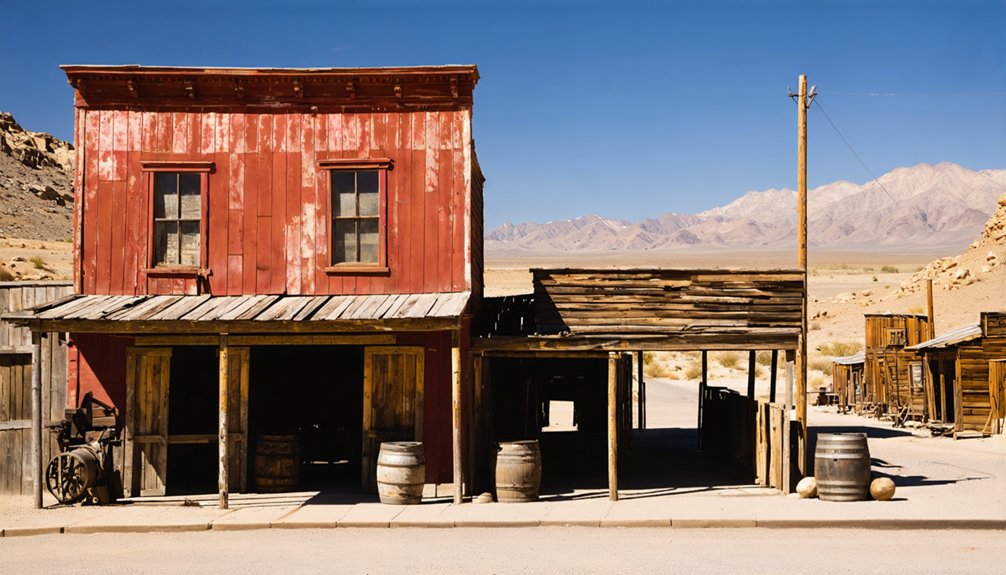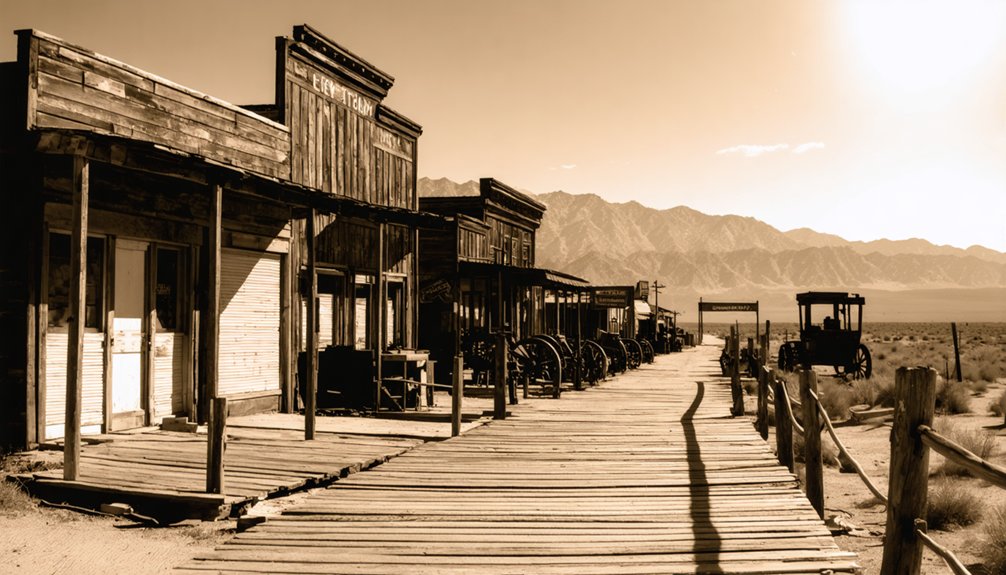Calico, California is a former silver mining boomtown established in 1881 that once housed 3,500 residents. You’ll find a well-preserved ghost town that thrived until silver prices collapsed in the mid-1890s, leading to its abandonment by 1900. Walter Knott restored the town in the 1950s before it became a San Bernardino County park in 1966. Today, you can experience California’s officially designated Silver Rush Ghost Town through mine tours and historical exhibits. The town’s dramatic rise and fall tells a larger story about Western mining settlements.
Key Takeaways
- Calico is a former silver mining town established in the 1880s that became California’s largest silver producer by 1882.
- The town reached a population of 3,500 residents at its peak with over 500 active mines before declining.
- When silver prices plummeted in the 1890s, Calico was abandoned and eventually became a ghost town.
- Walter Knott restored Calico in the 1950s, preserving five original structures before it became a county regional park.
- Now designated as “California’s Silver Rush Ghost Town,” Calico offers tours, train rides, and gold panning for visitors daily.
Silver Discovery and the Birth of a Boomtown (1875-1882)
When prospectors first discovered silver deposits on the south slope of the Calico Mountains in 1875, few could have imagined the bustling boomtown that would soon emerge from the colorful desert landscape.
Initial findings weren’t immediately profitable, but the region’s geology proved rich with silver veins that would transform this barren terrain.
Though initially unpromising, the area’s unique geology harbored silver treasures that would revolutionize this desolate landscape.
The real catalyst came in 1881 with the discovery of the Silver King Mine, which implemented advanced mining techniques to extract high-grade ore worth up to $500 per ton.
Named after financier John C. King, this operation became California’s largest silver producer.
By 1882, you’d find a thriving community with a commercial street, post office, and weekly newspaper. The town’s population would eventually reach 2,500 by 1884, marking the height of Calico’s prosperity.
Similar to how wooden block printing was adopted for calico cloth manufacturing, mining techniques evolved rapidly to maximize silver extraction efficiency.
The “calico-colored” mountains not only gave the town its name but defined its destiny.
Life in Calico During the Peak Mining Years
As silver extraction intensified throughout the 1880s, Calico transformed from a scattered collection of tents into a vibrant community of 3,000-3,500 residents representing diverse nationalities and backgrounds.
You’d encounter Chinese, Irish, English, Greek, and Dutch immigrants all working alongside Americans in this bustling mining community.
The town’s cultural diversity reflected in its infrastructure—over 500 active mines operated while businesses catered to miners’ needs.
You’d find hotels, restaurants, saloons, and essential services like the post office established in 1882.
Life wasn’t easy. Miners faced dangerous conditions and the harsh desert environment where water scarcity presented constant challenges. The Silver King Mine, established in 1881, became the foundation of the town’s economic prosperity. The town reached its zenith in 1893 when it became California’s largest silver producer.
Despite these hardships, residents established schools and created a community identity through saloons and social gatherings where diverse traditions blended in this rugged, freedom-seeking frontier society.
The Decline and Abandonment of Calico
When you visit Calico today, you’re walking through the remains of a once-thriving community that faced rapid decline after silver prices plummeted from $1.31 to 63 cents per ounce in the mid-1890s.
This economic collapse, partially caused by federal legislation changes like the Sherman Silver Purchase Act, triggered a mass exodus as mining operations became unprofitable and residents sought opportunities elsewhere.
By the early 1900s, the former boomtown that once boasted 3500 residents had completely transformed into an abandoned ghost town as the last mining operations ceased.
The town’s remarkable legacy of producing $20 million in silver ore from approximately 500 mines during its heyday stands in stark contrast to its eventual abandonment.
Silver Boom Collapse
The dramatic collapse of silver prices in the late 19th century dealt a devastating blow to Calico’s prosperity, triggering the town’s ultimate abandonment.
You can trace this decline to silver’s price freefall from $1.31 per ounce in the 1880s to merely 57 cents by 1896, exacerbated by the Silver Purchase Act of 1890’s disastrous silver market dynamics.
These economic repercussions forced over 500 once-profitable mines to close, despite having produced more than $20 million in silver ore.
As mining operations ceased, Calico’s population of 3,500 rapidly dispersed. The post office’s closure in 1898 marked the administrative death of the community.
Even attempts to salvage the economy through borax mining proved futile, with that industry collapsing by 1907, leaving Calico to the mercy of the harsh Mojave Desert.
The ghost town remained largely abandoned until Walter Knott purchased the property in 1950 with only five buildings still standing from its once-thriving days.
After his restoration efforts, the site was officially recognized as State Historical Landmark 782 in 2005, preserving this important piece of California’s mining heritage.
Fire and Exodus
Devastating fires played a significant role in hastening Calico’s decline beyond the economic collapse of its silver mining industry.
In spring 1883, flames ravaged much of the camp during its early boom period, coinciding with a miner exodus triggered by nearby borax discoveries. As silver prices plummeted, these dual catastrophes accelerated the town’s abandonment.
By the mid-1890s, most inhabitants had relocated, leaving buildings to decay or be dismantled. This period of decline continued until Walter Knott’s 1950s intervention, when he invested $700,000 in historical preservation efforts based on original photographs. The town’s population had dwindled from its peak of 1,200 residents during the mining boom to virtual abandonment by 1907.
His meticulous restoration countered decades of fire damage and neglect.
The 2001 blaze, attributed to aging electrical lines, reinforced the importance of fire safety in protecting Calico’s heritage as California’s officially designated Silver Rush Ghost Town.
Walter Knott’s Vision: Restoration of a Ghost Town
Mining town preservationist Walter Knott acquired Calico ghost town from the Zenda Mining Company in 1950-1951, initiating an ambitious restoration project that would ultimately revive a piece of California’s silver mining heritage.
Investing approximately $700,000, Knott employed restoration techniques that balanced historical accuracy with practical tourism needs. His art director, Paul von Klieben, oversaw architectural reconstruction based on period photographs and longtime residents’ memories.
This restoration work has been characterized as “de-ghosting a ghost town” in recent publications discussing historical preservation techniques.
Calico’s Historical Recognition and Legacy

Following its heyday as a bustling silver boomtown, Calico’s legacy endured through significant historical recognition that cemented its place in California’s cultural heritage.
The town’s historical significance was formally acknowledged in 1962 when it received designation as California Historical Landmark #782, following Walter Knott’s pioneering preservation efforts in the early 1950s.
Three milestones in Calico’s recognition include:
- Walter Knott’s meticulous restoration between 1951-1953, preserving five original structures
- The 1966 donation to San Bernardino County, establishing a 480-acre regional park
- Governor Schwarzenegger’s 2005 proclamation naming Calico “California’s Silver Rush Ghost Town”
You’ll find Calico’s story particularly compelling as it exemplifies the boom-and-bust cycle typical of Western mining towns, while offering an authentic glimpse into frontier life through careful preservation.
Exploring Calico Today: Activities and Visitor Information
Today’s visitors to Calico Ghost Town can immerse themselves in a meticulously preserved slice of California’s silver mining past through a variety of authentic experiences and attractions.
Located at 36600 Ghost Town Road in Yermo, Calico operates daily from 9 AM to 5 PM, charging a modest entry fee with additional costs for specific attractions.
Family activities abound, including narrow-gauge train rides, gold panning, Mystery Shack exploration, and mine tours that illuminate the town’s 1880s heritage. Annual events like Calico Days and Halloween Ghost Haunt enliven the historical setting.
Visitor amenities include on-site accommodation options from RV camping to cabins, along with picnic areas and restrooms. For the best experience, arrive early on winter mornings when temperatures are milder and crowds thinner.
Access requires personal transportation via I-15 North.
Frequently Asked Questions
Are There Reports of Paranormal Activity or Ghosts in Calico?
Yes, you’ll find numerous ghost sightings in Calico, including Lucy Lane, Tumbleweed Harris, and school spirits. Paranormal investigations report unexplained touches, chills, and moving objects throughout the historic buildings.
What Happened to the Original Residents After the Town’s Decline?
After Calico’s decline, you’d find original residents scattering to nearby towns like Barstow. They relocated buildings, sought new mining opportunities elsewhere, and adapted to different professions following the devastating economic collapse.
How Accurate Is the Current Restoration to the Original Town?
Calico’s restoration achieves partial historical accuracy through Walter Knott’s preservation techniques. While only five original buildings remain, Knott used photographs and resident accounts to recreate the 1880s mining town’s appearance you’ll experience today.
Were Any Famous Outlaws or Notable Historical Figures Associated With Calico?
Surprisingly, while you may have heard stories connecting Butch Cassidy or Wild Bill to Calico, neither visited. John King (sheriff), Walter Knott (restorer), and Dorsey (mail-carrying dog) were Calico’s true notables.
What Natural Hazards or Weather Conditions Should Visitors Prepare For?
You’ll need to prepare for extreme temperature swings, heat waves, UV radiation, and occasional flash floods. Pack layers, sun protection, and water. Monitor weather forecasts for sudden precipitation events.
References
- https://www.legendsofamerica.com/ca-calico/
- https://californiathroughmylens.com/calico-ghost-town/
- https://parks.sbcounty.gov/park/calico-ghost-town-regional-park/
- https://en.wikipedia.org/wiki/Calico
- https://kids.kiddle.co/Calico
- https://parks.sbcounty.gov/opinion-beyers-byways-a-brief-history-of-calico-ghost-town/
- https://cactusatlas.com/adventures/calico-ghost-town/
- https://www.youtube.com/watch?v=ILv_uPHtpyM
- http://poorlygradedgravel.blogspot.com/2011/02/ghost-town-tuesday-calico-california.html
- https://capitolmuseum.ca.gov/state-symbols/silver-rush-ghost-town-calico/



